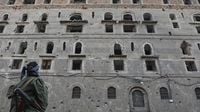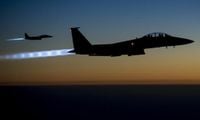On Wednesday, September 10, 2025, a new and deadly front erupted in the Middle East as Israeli fighter jets launched a barrage of airstrikes on Houthi-controlled targets in Yemen, killing at least 35 people and wounding more than 130, according to the Houthi-run health ministry. The strikes, which pounded the Yemeni capital of Sanaa and the northern province of Al-Jawf, marked a sharp escalation in the ongoing regional conflict linked to the war in Gaza.
According to the Israel Defense Forces (IDF), the airstrikes targeted military camps, the headquarters of the Houthis’ military information department, and a fuel storage facility believed to support militant operations. The IDF described these locations as centers where Houthi operatives gathered intelligence and planned attacks. Reuters, citing sources, reported that one of the strikes hit the Houthis’ Ministry of Defense in central Sanaa. Al-Masirah, a Houthi-controlled news channel, confirmed that a military headquarters building in the city center was struck, with neighboring houses also damaged in the blasts.
The Israeli assault came in direct response to a Houthi drone attack just days earlier, on Sunday, September 7, 2025, in which a drone managed to breach Israel’s multilayered air defenses and slammed into a southern airport. The Houthis, an Iranian-backed group that controls much of northern Yemen, have repeatedly claimed responsibility for launching drones and missiles at Israel during the ongoing war in Gaza, asserting their support for Hamas and the Palestinians.
Essam al-Mutawakel, spokesperson for the rebel-run Yemen Petroleum Company, told Al-Masirah that the strikes also hit a fuel station supplying hospitals in Sanaa, raising fears about the impact on already struggling medical services. Residents described violent explosions that lit up the night sky, with fire and smoke visible across multiple areas of the capital. The Houthi media office reported that a government facility in Hazm, the capital of northern Jawf province, was also struck.
As search crews dug through the rubble in Sanaa, Houthi military spokesman Brig. Gen. Yahya Saree claimed that the rebels fired surface-to-air missiles at the Israeli fighter jets during the raids. Houthi-backed President Mahdi al-Mashat issued a warning to Israelis, stating, “Stay alarmed since the response is coming without fail.” These words underscored the risk of further escalation between Israel and the Houthis, whose ties to Iran have long been a source of regional tension.
The airstrikes in Yemen were not an isolated event. Just a day earlier, on September 9, 2025, Israel had launched a highly controversial airstrike in Qatar, targeting residential buildings in Doha that housed members of Hamas’s political bureau. The strike killed at least six people, including a Qatari officer and the son of Hamas official Khalil al-Hayya. The attack on Qatari soil drew sharp condemnation from the United Nations Secretary-General António Guterres and several governments, including Qatar, Saudi Arabia, and the United Kingdom, who decried it as a violation of sovereignty. According to BNO News, President Trump emphasized that Israel had acted unilaterally, stating the U.S. was not involved in the decision.
The strikes in Yemen and Qatar have added further fuel to the fire of an already volatile region. The Houthis’ retaliatory attacks and Israel’s willingness to strike beyond its borders have deepened concerns about the conflict’s potential to spiral out of control. The Houthis, for their part, have vowed to continue supporting Hamas and carrying out attacks on Israel, framing their actions as solidarity with Palestinians in Gaza.
Meanwhile, the humanitarian crisis in Gaza continues to worsen. The Gaza Health Ministry reported that 126 Palestinians, including 26 children, have died from causes related to malnutrition since August 22, 2025, when international experts declared a famine in Gaza City. Since the war began, a total of 404 people, including 141 children, have died from malnutrition-related causes. The war, which erupted on October 7, 2023, when Hamas militants stormed into southern Israel—killing about 1,200 people and abducting 251 hostages—has since claimed the lives of more than 64,600 Palestinians, according to the Gaza Health Ministry. The ministry does not distinguish between civilian and combatant casualties but notes that women and children constitute about half of the dead.
Israel, for its part, denies that starvation is occurring in Gaza and insists it is allowing sufficient humanitarian aid into the territory. However, international scrutiny is mounting. On September 10, 2025, European Commission President Ursula von der Leyen announced plans to seek sanctions and a partial trade suspension against Israel over its conduct in the Gaza war. “Man-made famine can never be a weapon of war. For the sake of the children, for the sake of humanity. This must stop,” von der Leyen declared to applause at the European Parliament in Strasbourg, France. She also signaled an intention to freeze European Union support to Israel, though the details of the aid and the likelihood of EU-wide consensus remain unclear, given the bloc’s deep divisions over the Israeli-Palestinian conflict.
Israel’s military has also reiterated its calls for about 1 million Palestinians to evacuate Gaza City as it ramps up a new offensive aimed at taking over the largest city in the territory. Many Palestinians, however, have refused to leave, citing exhaustion, lack of resources, and nowhere safe to go. “There is no safe zone in the Gaza Strip,” said Fawzi Muftah, echoing the desperation of many as they flee with what little they have left. Amal Sobh, a displaced woman caring for 30 relatives, including 13 orphans, lamented, “We don’t have good blankets or good beddings, and winter is coming, what do we do for our children? We don’t even have a proper tent to shelter us.”
As the region reels from these latest events, the international community is left grappling with the consequences. The Israeli strikes in Yemen and Qatar have drawn condemnation and heightened fears of a broader conflagration. Within Gaza, the humanitarian toll continues to mount, with no clear end in sight. And in Europe, political leaders face the challenge of forging a united response to a conflict that shows no sign of abating. The world watches, anxious and uncertain, as the cycle of violence and reprisal threatens to engulf even more lives.
There is little doubt that the events of September 2025 have left the region more volatile than ever, with each new strike and counterstrike pushing the prospect of peace further from reach.


